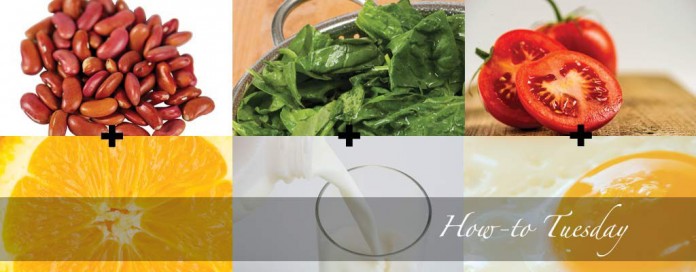The average adult should consume at least five servings of vegetables each day, plus two to four servings of fruit. Add dairy, grains and protein and you have a balanced diet. But did you know that if you consume certain foods with others, you can boost your nutrition?
Here are three pairings you should try to optimize the nutrients you’re getting from what you eat.
Iron and vitamin C
Michigan State University Extension explains that iron, which is found in meats, beans (black, pinto, kidney, soy and lentils), dark green leafy vegetables, and iron-fortified breakfast cereals. When these foods are consumed with vitamin C (found in citrus fruits, kiwi, tomatoes, potatoes, strawberries, bell peppers, broccoli and Brussels sprouts), the body absorbs more iron from plant sources.
Examples of pairings:
- Strawberries and oatmeal
- Orange juice and iron-fortified cereal
- Meat and potatoes
There should be at least 20 percent or more of the recommended daily allowance of iron in the food you’re pairing with vitamin C.
Calcium and vitamin D
University of Virginia Health System states that calcium can’t be absorbed without an adequate amount of vitamin D.
Calcium is commonly found in dairy products like milk and yogurt as well as kidney beans, collard greens, spinach, turnip greens, edamame and broccoli. Vitamin D can be absorbed through sunlight, giving it the name “the sunshine vitamin.” Vitamin D can also be found in fortified dairy products, egg yolks and fatty fish like salmon and herring.
Examples of pairings:
- Leafy vegetables and salmon
- Milk and eggs
- Drinking milk or eating yogurt while in direct sunlight
Carotenoids and fats
Oregon State University’s Micronutrient Information Center explains that carotenoids are red, orange and yellow pigments that naturally occur in fruits and vegetables. Carotenoids can be found in watermelon, red peppers, tomatoes, carrots, pumpkins, tangerines, yellow corn and even peas, spinach and kale.
There are more than 600 carotenoids, with A-carotene, B-carotene, lycopene and lutein being some of the most common ones. Carotenoids are best absorbed with fats. Eggs are sources of dietary lipids, or fats, and so are oils. More carotenoids become available when vegetables are chopped, pureed and cooked in oil.
Examples of pairings:
- Add eggs to salads full of carotenoid-rich vegetables
- Use oil-based dressing on salads
- Tomato and olive oil










